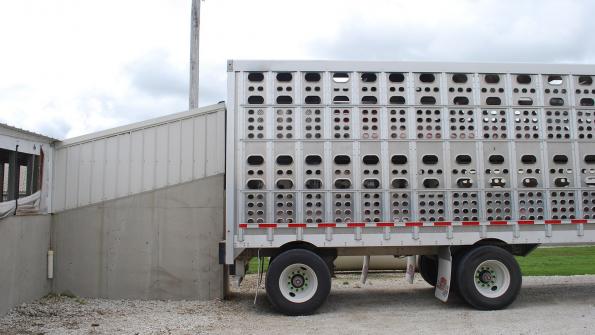Just enough hog slaughter capacity?
Slaughter weights have been holding steady this fall. That is an indication that we haven’t created a backlog of hogs that will have to be worked through.

By the time 2016 comes to an end, it will have set records for the largest yearly, quarterly, weekly and daily hog slaughter. The record for monthly hog slaughter was set in October 2012, which had 23 weekdays. October 2016 had only 21 weekdays.
Of course, record slaughter means extremely low hog prices. From mid-June to mid-November the national negotiated base hog carcass price declined in 20 of 21 weeks, dropping from $80 per hundredweight to $40 per hundredweight.
During the same 21-week period, the pork cutout value dropped from $89 per hundredweight to $73 per hundredweight. The question on producers’ minds is when will hog prices hit bottom? The answer, we all hope, is soon.
The much faster decline of hog price relative to cutout value is an indication that slaughter capacity has been stretched thin. In recent days, the negotiated base hog carcass price has been less than 60% of the pork cutout value. That is the lowest percentage thus far this century, and is approaching the historic lows of late-1998.
Hog prices were disastrously low in November and December of 1998 because the supply of market-ready hogs exceeded packers’ capacity to slaughter them.
Steve Meyer, vice president of Express Markets Inc. annually estimates the nation’s hog slaughter capacity. He does it the hard way by surveying all the major hog packers and then summing their responses.
[CHARTBEAT:3]
I do it an easier way: simply wait and see how many hogs packers kill. Of course Steve’s number is out ahead of the slaughter crunch and my approach only works after the fact and then only when packers actually have been running flat out. But, this fall packer margins have been fabulous and they have had good reason to process as many hogs as they could handle.
Looking at this fall’s slaughter data: daily hog slaughter has been 443,000 or more 12 times; 444,000 or more three times; and 444,500 or more zero times. The biggest daily kill was 444,434 on Oct. 18. So, I’m saying that daily slaughter capacity is pretty close to 444,500 hogs.
Note: USDA’s Agricultural Marketing Service reported 460,768 hogs slaughtered on Oct. 31, but a good portion of those were slaughtered on the Sunday before.
This fall, weekly hog slaughter has been 2.40 million or more eight times; 2.50 million or more three times; and 2.54 million or more zero times. The biggest weekly hog kill was 2,532,244 for the week ending on Nov. 5. So, I’m saying that weekly hog slaughter capacity is about 2.54 million head.
Prior to this fall, the record for most hogs slaughtered in a week was 2,498,954 processed the week ending on Dec. 18, 2015. Daily and weekly hog slaughter records are usually set late in the year. Fourth-quarter slaughter is almost always the highest of the year. Since slaughter plants don’t operate on Thanksgiving, Christmas and New Year’s Day, there are more hogs available for slaughter on the surrounding days.
The three non-holiday weeks between Thanksgiving and Christmas often have very big slaughter totals. Last fall, hog slaughter totaled a bit over 2.4 million each of these three weeks. These were the only weeks in 2015 with hog slaughter above 2.4 million head.
The September hogs and pigs report said the number of market hogs weighing 50-119 pounds on Sept. 1 was up 1.9% year-over-year. These are the market hogs that should be headed to slaughter during December. If USDA’s 50-119 pound market hog inventory is right, then the non-holiday weeks in December should average close to 2.5 million hogs each. Since packers have already processed 2.5 million hogs in a week three times this fall (although not in consecutive weeks) these projected December slaughter numbers should be doable.
The concern arises if USDA’s 50-119 pound market hog inventory number is too low. Then packers may not be able to keep up with the hog run next month. In that case, the bottom in hog prices may not come until after Christmas.
If USDA’s market hog inventory number is too high, then slaughter capacity is more than adequate and packers are likely to chase hogs next month. It that case, hog prices will probably bottom in early December.
Lest you decide there is no reason to worry, it may be worth mentioning that based in fall hog slaughter levels, it appears that USDA’s September inventory of market hogs weighing 120 and up was a bit over 1% too low.
One hopes that hogs aren’t being backed up on the farm. The best indicator of how current producers are in their marketing is hog weights. In November and December of 1998 when the available supply of slaughter hogs clearly exceeded slaughter capacity, live hog prices dropped below $20 per hundredweight for two months and Iowa-Minnesota slaughter weights jumped nearly 10 pounds from the start of October to the start of December. This fall, slaughter weights have been holding steady. That is an indication that we haven’t created a backlog of hogs that will have to be worked through.
Once we make it through 2016, next fall should be a breeze. Two new, large slaughter plants (Coldwater, Mich., and Sioux City, Iowa) are scheduled to come on line in late-summer of 2017. There should be plenty of slaughter capacity to handle hog numbers for the next several years.
About the Author(s)
You May Also Like





